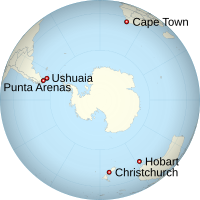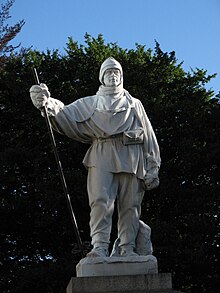Antarctic gateway cities
 |
The Antarctic gateway cities are five cities on the rim of the Southern Ocean through which nearly all cargo and personnel bound for Antarctica pass.[1] From west to east, they are Punta Arenas, Chile; Ushuaia, Argentina; Cape Town, South Africa; Hobart, Australia; and Christchurch, New Zealand. As Antarctica is a low-resource environment with no major transportation infrastructure of its own, gateway cities are a necessary part of all Antarctic activities.
Each of the gateway cities accommodate both planes and ships traveling to Antarctica, and generally service the areas of the continent closest to them. The cities are used by both national Antarctic programs and Antarctic commercial tourism companies, although they differ in how much of each they facilitate. As a result of their status as transportation hubs, the cities also have cultural, economic, ecological, and political connections to Antarctica.
History
[edit]Early Antarctic exploration
[edit]
In the 1820s when mainland Antarctica was first discovered, the current gateway cities didn't have the infrastructure to support expeditions so ships departed from more northerly ports such as Valparaíso, Chile and Sydney, Australia.[2][3] The current gateway cities began establishing themselves as important Antarctic supply hubs around the turn of the 20th Century when several of the most notable Heroic Age expeditions first traveled through them, beginning with the British Southern Cross Expedition in 1898.[4]
| Punta Arenas | Ushuaia | Cape Town | Hobart | Christchurch |
|---|---|---|---|---|
|
|
|
21st century
[edit]Though the cities operated almost entirely independently through most of their history as Antarctic gateways, the cities have made efforts to build relationships with one another in the 21st century. In 2009, officials from each city met in Christchurch and signed a "Statement of Intent Between the Southern Rim Gateway Cities to Antarctica"[14] to promote peaceful cooperation among the cities.[15] The statement expired two and a half years later. From 2017 to 2020, an Australian-led project called Antarctic Cities recruited partners from each of the gateway cities to study their relationship with one another and with Antarctica. The project aimed to transition the cities from gateways, which participate in purely transportation activities, to custodial cities, which also participate in Antarctic stewardship activities.[16] If geographic proximity to Antarctica is not considered necessary, other cities could also be called Antarctic gateways or become gateways in the future. For instance, Shanghai has a growing role through the Polar Research Institute of China and could potentially become recognized as a gateway city in the future.[14]
Public relationship to Antarctica
[edit]A 2020 survey found that roughly three-quarters of respondents from each of the gateway cities felt Antarctica was "very/fairly important to the city's identity."[17] A majority of respondents also reported feeling "very/fairly responsible for Antarctica's future"[17] and that it was important for their city to develop a relationship with Antarctica to promote better care for the environment.[17] In recent years the cities have seen efforts by municipal officials to promote stronger relationships with the continent, such as Antarctic festivals, education programs for K-12 students, museum exhibits, and public outreach campaigns.[18]
Cities
[edit]Punta Arenas
[edit]Punta Arenas is located on the Southern Cone near the Antarctic Peninsula. More than 20 national Antarctic programs travel through Punta Arenas, more than any other gateway city.[1] In 2016 the municipal government launched a project to increase infrastructure and promote a cultural connection to Antarctica.[19]
Ushuaia
[edit]
Ushuaia is the most southerly of the gateway cities and is located roughly 1000 km from the Antarctic Peninsula. Ushuaia is by far the most popular gateway city for tourism to Antarctica, accounting for 90% of all tourists to the continent.[18] Nearly all of the passengers departing Ushuaia for Antarctica travel by cruise ship. It services Argentina's own National Antarctic Directorate, but no other national Antarctic program.[20] It is also home to Antarctic-related tourism attractions, such as the Antarctic Museum.[21]
Cape Town
[edit]Cape Town is the largest of the gateway cities and the farthest from Antarctica. In addition to South Africa's own national Antarctic program, the programs of Russia, Germany, Belgium, Norway, and Japan also reach Antarctica via Cape Town.[1] As of 2021, tourism company White Desert has offered direct commercial flights from Cape Town to Antarctica.[22]
Hobart
[edit]Hobart services the national Antarctic programs of Australia, France, and China.[1] Hobart offers the least transportation to Antarctica among the gateway cities, but has the highest number of Antarctic scientists.[1] It also houses several Antarctic policy and research organizations including the Convention for the Conservation of Antarctic Marine Living Resources, the Institute for Marine and Antarctic Studies at the University of Tasmania, the Tasmanian Polar Network, and Antarctica Tasmania. It also hosts Antarctic museum exhibits and an annual Australian Antarctic Festival.[23][24]
Christchurch
[edit]
Christchurch offers almost no commercial travel to Antarctica, but it is a logistics center for the national Antarctic programs of New Zealand, the United States, Italy, and South Korea.[1] Christchurch also houses the headquarters for the Council of Members of National Antarctic Programs, an international organization comprising representatives from each of the governmental research programs operating in Antarctica.[25] In addition to its services for national Antarctic programs, Christchurch is home to several locations and events for the local public. These include the International Antarctic Centre, the Christchurch Antarctic Office, an annual Antarctic festival called Days of Ice, and many permanent museum exhibits.[26][27] The local University of Canterbury houses Gateway Antarctica, a center for Antarctic studies and research.[28]
References
[edit]- ^ a b c d e f Salazar, Juan Francisco; James, Paul; Leane, Elizabeth; Magee, Liam (2021). Antarctic Cities: From Gateways to Custodial Cities. Sydney: University of Western Sydney. ISBN 9781741085280.
- ^ "Pat Falvey Beyond Endurance Expeditions & Film Production – Arctic, A…". archive.ph. 2012-07-23. Archived from the original on 2012-07-23. Retrieved 2022-02-21.
- ^ "Fabian Gottlieb von Bellingshausen". Antarctic Logistics & Expeditions. 2010-08-28. Retrieved 2022-02-21.
- ^ Reader's Digest (1990). Antarctica, the Extraordinary History of Man's Conquest of the Frozen Continent. Reader's Digest. ISBN 0864381670.
- ^ "The Second French Antarctic Expedition 1". Nature. 85 (2147): 257–258. 1910-12-01. Bibcode:1910Natur..85..257.. doi:10.1038/085257a0. ISSN 1476-4687. S2CID 29662093.
- ^ Balch, Edwin Swift (1911). "Charcot's Antarctic Explorations". Bulletin of the American Geographical Society. 43 (2): 81–90. doi:10.2307/200126. ISSN 0190-5929. JSTOR 200126.
- ^ Plymouth History Festival (2011). "Discovery Expedition Timeline" (PDF). Plymouth History Fest.
- ^ a b "History of Scott's Expedition". Antarctic Heritage Trust. Retrieved 2022-02-27.
- ^ "The Southern Cross expedition » Breaking the Ice". Breaking the Ice. Retrieved 2022-02-27.
- ^ Macgregor, Colin (2020-06-04). "Heading south: Mawson and the Australasian Antarctic Expedition". The Australian Museum. Retrieved 2022-02-27.
- ^ "Antarctica's Links with Tasmania". www.utas.edu.au. Retrieved 2022-02-27.
- ^ "History of Scott's Expedition". Antarctic Heritage Trust. Retrieved 2022-02-27.
- ^ a b "NZ ports and Antarctica". nzhistory.govt.nz. Retrieved 2022-02-27.
- ^ a b Chambers, Claire; Sima, Ellen; Laubscher, Laetitia; Turnbull, Morag; Chen, Xu (2016). Antarctic Gateway Cities (Postgraduate Certificate in Antarctic Studies thesis). Gateway Antarctica, University of Canterbury. hdl:10092/14302 – via UC Research Repository.
- ^ "Antarctica agreement signed". RNZ. 2009-09-25. Retrieved 2022-02-22.
- ^ "Antarctic Cities – Antarctic Cities and the Global Commons". Retrieved 2022-02-22.
- ^ a b c Leane, Elizabeth; Salazar, Juan Francisco; Marx, Katie; Magee, Liam; Khan, Marina; James, Paul. "Custodians of Antarctica: how 5 gateway cities are embracing the icy continent". The Conversation. Retrieved 2022-02-22.
- ^ a b "Reimagining Antarctic 'Gateway' Cities". Circles of Sustainability. Retrieved 2022-02-21.
- ^ Leane, Elizabeth; Salazar, Juan Francisco; Magee, Liam; James, Paul. "Five cities that could change the future of Antarctica". The Conversation. Retrieved 2022-02-22.
- ^ Roldan, Gabriela (February 2011). "Fit for the Ice: Analyzing the Infrastructure in Antarctic Gateway Cities" (PDF). University of Canterbury Research Depository.
- ^ "Museo Antártico Ushuaia". MUSEO MARÍTIMO DE USHUAIA (in Spanish). Retrieved 2022-02-21.
- ^ "White Desert introduces direct flights from Cape Town to Antarctica". www.capetownetc.com. Retrieved 2022-02-21.
- ^ Services, IT Web. "Tasmanian Museum and Art Gallery | Islands to Ice". Tasmanian Museum and Art Gallery. Retrieved 2022-02-21.
- ^ "Antarctic Festival – Mawson's Huts Foundation". Retrieved 2022-02-21.
- ^ "Contacts". COMNAP. Retrieved 2022-02-27.
- ^ Interactive (https://www.nvinteractive.com), N. V. "About The Christchurch Antarctic Office". www.christchurchnz.com. Retrieved 2022-02-27.
- ^ Interactive (https://www.nvinteractive.com), N. V. "Days of Ice Festival - Celebrating Antarctica". www.christchurchnz.com. Retrieved 2022-02-27.
- ^ "Gateway Antarctica | College of Science". The University of Canterbury. Retrieved 2022-02-21.
